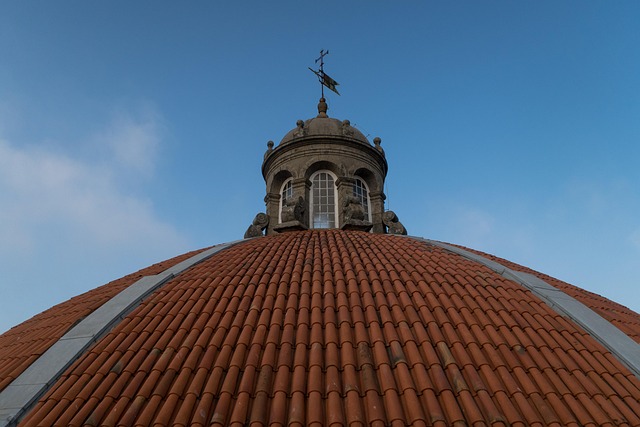Cedar roofing is a popular choice for its rustic allure and durability. Cedar shakes and shingles, derived from western red cedar, offer superior protection against moisture, insects, and extreme temperatures. Installation involves preparing the roof deck, installing underlayment, placing starter strips, and applying shakes/shingles in even courses. Regular maintenance, including inspection and sealing, is crucial to prolong its lifespan. Proactive care, such as inspections and repairs, combats rot and weather-related damage, ensuring a durable natural wood roof.
Looking to enhance your home with a timeless and rugged aesthetic? Consider the trusted installation of cedar shingle roofing. This natural wood option offers superior durability and weather resistance, making it a popular choice for homeowners seeking a rustic roof that stands the test of time. From understanding the benefits and types of cedar roofing materials to mastering installation, maintenance, and repair techniques, this comprehensive guide covers all aspects of traditional cedar shingles, ensuring your new roof is both functional and striking.
- Understanding Cedar Roofing Materials: Benefits and Types
- The Installation Process: Step-by-Step Guide for Cedar Shakes/Shingles
- Maintenance and Longevity: Caring for Your Rustic Natural Wood Roof
- Common Issues and Repair Tips for Traditional Cedar Roofing
Understanding Cedar Roofing Materials: Benefits and Types
Cedar roofing is a popular choice among homeowners for its rustic allure and natural beauty. Cedar shakes and shingles, derived from western red cedar or other similar species, offer more than just an aesthetically pleasing roof. These materials are renowned for their durability and weather resistance, making them a long-lasting option for any home. The unique structure of cedar wood provides excellent protection against moisture, insects, and extreme temperatures, ensuring your roof remains in top condition for years to come.
There are various types of cedar roofing available, each with distinct characteristics. Traditional cedar shakes, for instance, are hand-split, creating a distinctive, uneven surface that adds character to the roof. Shingles, on the other hand, are machine-sawn and feature a more uniform appearance. Both options provide excellent coverage and protection but differ in installation methods and visual appeal. Proper maintenance, including regular cleaning and inspection, can further enhance the life and look of a cedar roof, ensuring it remains a stunning and durable choice for any property.
The Installation Process: Step-by-Step Guide for Cedar Shakes/Shingles
The installation process for a cedar roofing system involves several meticulous steps to ensure a durable and aesthetically pleasing finish. It begins with preparing the roof deck, ensuring it’s clean, dry, and free from any debris or imperfections. A proper underlayment is then installed, providing an essential barrier against moisture intrusion. This is followed by the placement of starter strips, which serve as the first course of shingles, creating a secure base for the rest.
The next step involves positioning the cedar shakes or shingles, starting from one end and working across the roof in even courses. Each shake/shingle is securely fastened with nails specifically designed for this material, ensuring proper overlap and alignment. Gaps are sealed with a high-quality sealant to lock in the natural beauty and weather resistance of the cedar. Regular maintenance, including inspecting for loose or damaged shingles, will prolong the life of this traditional yet robust natural wood roof.
Maintenance and Longevity: Caring for Your Rustic Natural Wood Roof
Caring for a cedar roofing system is key to ensuring its longevity and maintaining the rustic charm of your natural wood roof. Unlike other roofing materials, cedar shingles and shakes require regular attention due to their organic composition. A proper maintenance routine involves inspecting the roof for any signs of damage, such as missing or curled shingles, which could lead to water infiltration and structural weaknesses.
Regular cleaning is another essential aspect of cedar roof maintenance. Accumulated debris, especially in the gutters, can cause blockages leading to water damage. Using a soft brush or vacuum attached to a ladder can effectively remove dirt and leaves without causing shingle wear. Additionally, applying a protective coat of sealant every few years can enhance the weather-resistance of your cedar roofing, safeguarding it against the elements and ensuring its durability for years to come.
Common Issues and Repair Tips for Traditional Cedar Roofing
Traditional cedar roofs, while aesthetically pleasing and offering a natural charm, are prone to certain issues that require regular maintenance and repairs. One of the primary concerns is the potential for rot and fungal growth, especially in areas with high moisture content. This can be attributed to poor ventilation, leaks, or inadequate protection against water penetration. Over time, cedar shingles may also become loose or curled due to exposure to varying weather conditions, leading to weak spots in the roof that could compromise its integrity.
To address these common issues, regular inspection and prompt repair are essential. Replacing damaged or deteriorated shingles promptly can prevent further decay and structural damage. Consider enhancing ventilation within the roof cavity to reduce moisture buildup and ensure proper air circulation. Additionally, applying water-repellent treatments and sealers can make the cedar more weather-resistant and protect against rot. Regular cleaning and maintenance will help keep the rustic wood roof in top condition, ensuring its longevity and beauty.
Trusted installation and proper maintenance are key to enjoying the lasting beauty and durability of a cedar shingle roofing system. By understanding the benefits and types of cedar, following a meticulous installation process, and implementing effective care strategies, homeowners can preserve the rustic charm and natural insulation of their cedar roofs for years to come. Regular inspection and prompt repair for common issues will ensure your traditional cedar roofing stands strong against the elements, providing a weather-resistant solution that enhances your home’s curb appeal.
